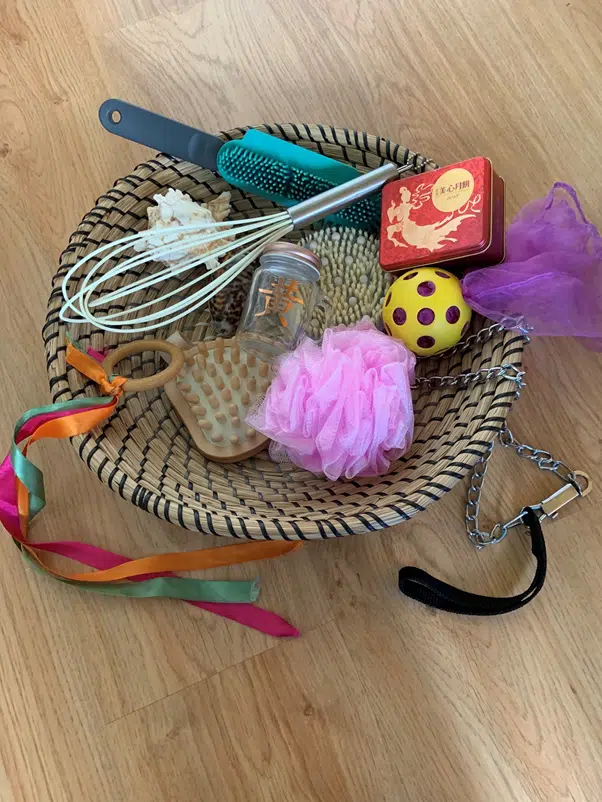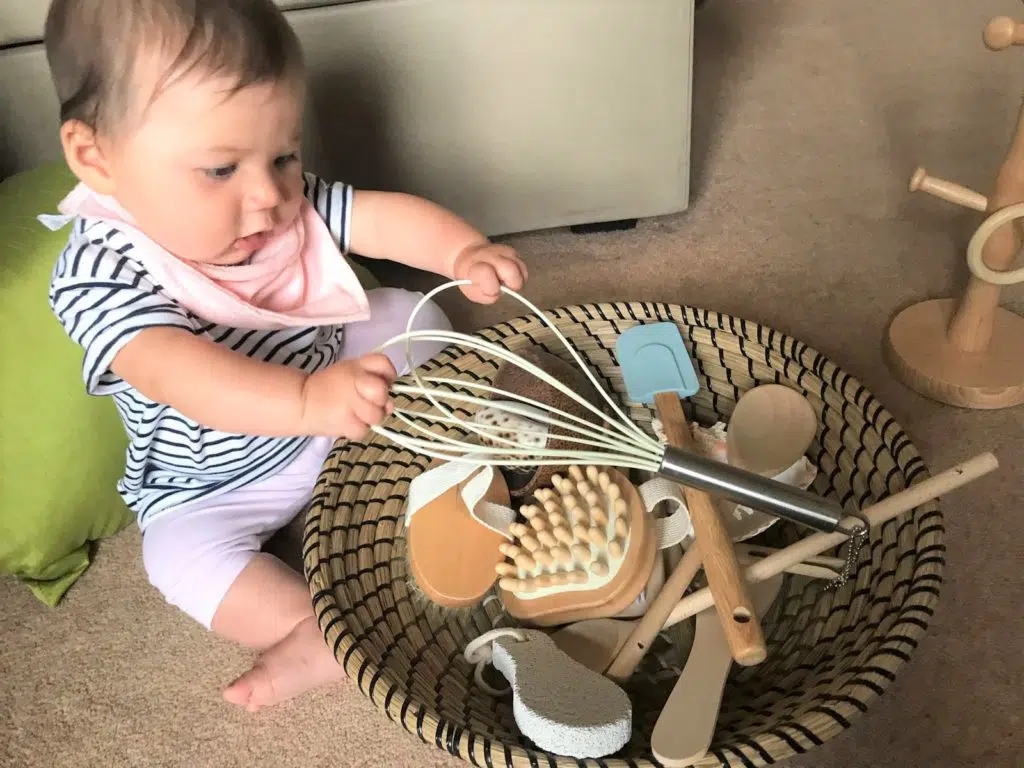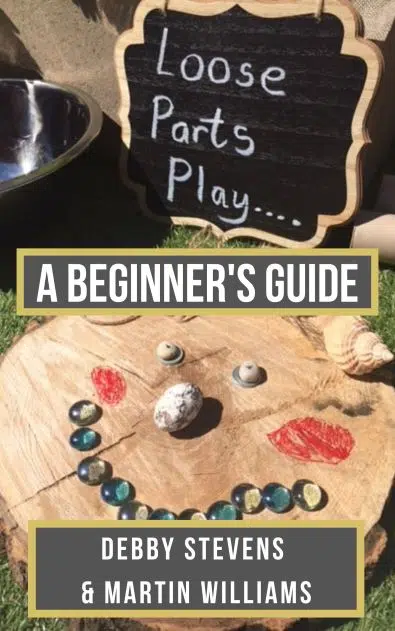You may well have heard other parents or fellow educators talk about treasure baskets, and wondered what they are. Many people use these baskets as a fantastic way of stimulating interest in babies, and in creating a multi-level learning opportunity for them. But what exactly is a treasure basket?
A treasure basket is a shallow basket usually made of wicker that contains a range of random everyday objects. These items have been selected to stimulate the curiosity of babies, who will interact independently with the objects whilst sitting up.
Treasure basket play is simple, but one that reaps great rewards. If you want to find out the the importance of treasure basket play then I have written an article all about the most important 16 benefits. At its best treasure baskets create that sense of ‘awe and wonder’, with babies being excited and fully focussed on what they are doing.
I will look at some of the key questions you may have about treasure baskets, and attempt to answer them in the simplest way possible.

How Old Should Children Be When They Use Treasure Baskets?
Babies are normally old enough to play with treasure baskets from when they are first sitting up.
To start with, it is fine if the baby is sitting up with support.
Many babies are somewhere around the six month mark when they begin to sit up, often with support (which is fine). They are normally safe to continue playing with treasure baskets until they begin to be moving round quite a bit, and are trying to move the objects around the room.
This is when you want to transition to ‘heuristic play’. Heuristic play is in many ways similar to treasure basket play, but the big difference is movement. To find out the most important 18 benefits of heuristic play then check this article out.
For example, there are some things that you can put into a treasure basket that are safe for babies, that might be dangerous to slightly older children. For example, a heavy chain would be safe for babies to explore, but might be dangerous to toddlers that could wrap it around their necks. A baby would not have the ability to do this. For more information about how to manage risk in loose parts play then check this article out.
In practice, a good benchmark for treasure basket play is to use them between roughly the age of 6 months and one year.

What Type Of Basket Do You Use?
There are a few things to consider when selecting or buying a basket.
The most important are:
- Select a basket that is shallow. This helps the babies to reach in independently and take things out
- Get a basket with a reasonably heavy base. This will stop the basket over-turning when babies are taking things out of it
- Often treasure baskets are made of wicker. They could be also made from another preferably natural material, and definitely not plastic
- Select an aesthetically pleasing basket if you can
What Do You Put In Them?
It is relatively simple to find some interesting random objects to put into a treasure basket.
The idea is to put things in that will spark the interest of the baby.
Select objects based on their different feels, textures, shapes and look.
Ideally you want to think about the following:
- Have a mixture of man-made and natural objects
- Select items that have an interesting feel – e.g. are they soft, hard, prickly, squidgy, cold, warm etc
- Select some items that will stimulate other senses as well. For example, something with an interest smell, or something that makes a noise.
There are literally hundreds of items that you could use, but to give you a few ideas, why not try some of the following:
• Large pebbles
• Pumice stone
• Natural rope
• Curtain rings
• Spoons
• Coasters
• Leather purse/wallet
• Coloured ribbons
• Bag of herbs
• Heavy chains
• Nutcracker
• Candle holder
Treasure baskets can be assembled with either little money, or even better for free. Just find random objects around your house, or beg, borrow or steal from friends and family.
Luckily I have written an article called the complete guide to treasure basket ideas, where I list probably about 100 things you can put in treasure basket.

What Does Treasure Basket Play Look Like?
Babies will be sitting up and selecting objects out of basket that they will then investigate. They do this by touching them, and handling them in different ways. Children of this age will also be investigating objects by putting them in their mouths and this is absolutely fine.
Babies can pick up, drop, examine, experiment, roll and just generally investigate as their imagination dictates.
What Are The Benefits?
There are numerous positives to be found in treasure basket play.
Here are some of the most important benefits:
- They stimulate curiosity in babies. This sense of curiosity is a brilliant motivator for inspiring lifelong learning
- They develop children’s concentration. It is amazing the amount of time that some babies will play with a treasure basket. This huge quantity of focus and involvement stimulates high quality learning and brain development
- They are multisensory, and children learn through feel, sight, hearing, taste and smell
- They allow children to be decision makers. Children decided themselves on which objects to select out of a group. It is up to them to think how they can use and interact with them
- They develop independence and the child’s sense of self
If you want to read about the full set of reasons whey treasure baskets are so important to babies, then whey check my article 16 Benefits Of Using Treasure Baskets With Babies.
How Can I Make It Safe?
Treasure basket play is generally a pretty safe form of learning, but there are just a few simple pointers that it is a good idea to follow to avoid any mishaps. The main ones are:
- Don’t put in any small objects, or anything that could become a choking hazard if the child puts it into their mouth (which they almost certainly will)
- Similarly, make sure objects have no small loose parts that may become detached from the main object and also become a choking risk
- Be careful not to include anything that they might get their fingers trapped in. For example, a narrow whisk might be one to avoid.
- If a child is only just starting to sit up, then it is wise to sit behind them or prop them up to avoid them tumbling over
The Role Of The Adult
Ideally the adult will take quite a minor role in treasure basket play. You are not really there as a teacher, you are more of a facilitator. Let the children get on with their learning, without breaking their focus wherever possible.
How Often Can You Use Them?
Treasure baskets can be used regularly, potentially every day. However, if you do use the baskets this often, it is important to change the objects in them regularly. This way the child will still have that ‘awe and wonder’ experience that is vital for treasure basket play.
You will often be able to gauge how long each session should last by the response of the child. You can usually tell when they have had enough and getting bored.
In A Nursery Should They Be Out All The Time?
Treasure baskets could definitely be used as part of your continuous provision. However, if you do this, it is still important to keep some baskets aside for special occasions. A bit of freshness is critical in successful treasure basket learning.
What Do Children Progress Onto After Treasure Baskets?
When children begin to move around more, they will naturally progress onto heuristic baskets. This form of play is similar, only the objects in the heuristic baskets are selected to be moved around the setting.
Whereas a glass bottle with some coins in would be ideal for treasure basket play, this might be dangerous for toddlers if they threw it across the room, so should not be included in heuristic play.
After Heuristic Play, children will progress onto loose parts play. Some good article to read about this include:
Top Tips For Using Treasure Baskets
- Select a shallow basket with a firm base
- Select a range of objects with different feels, textures, properties, smells and sounds
- Facilitate the learning but try not to get too heavily involved
- Vary the objects in the baskets regularly to maintain that all important sense of ‘awe and wonder’.
Conclusion
Treasure basket play can be really magical when it all goes well, and babies will become fully involved and concentrating on an activity for an astonishing amount of time.
Treasure basket play is open to everyone. It is simple, cheap and easy to set up.
If you’ve never given it a go, then it’s time to give treasure basket play a go today.
What Next?
If you are either a parent of practitioner working with babies in the UK and want to find out more about strategies to use with babies and toddlers, then why not check out our range of early years training courses. We run these all over England and Wales. They are practical sessions with many hands-on resources.
This article was partly taken from our book This article is in part an extract from the book ‘Loose Parts Play – A Beginner’s Guide’ written by myself and my colleague Debby Stevens. Debby ran an outstanding loose parts nursery for more than ten years. This book provides a full, yet simple guide to setting up an outstanding loose parts culture in your home or educational setting with children aged 0-5. To check out the book on Amazon, then follow this link

